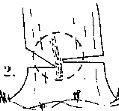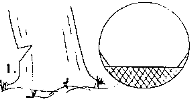Logging eTool
Making the Cuts » Special Techniques for Felling Difficult Trees

A large tree may be felled against its natural lean by inserting one or more wedges in the back cut. As the back cut is sawn, the wedges are driven in with an axe.
The amount of back lean that can be overcome is based on the height and diameter of the tree to be felled. The following methods determines the amount of back lean which can be overcome with 2 inches of wedging.
The following are unacceptable practices:
- Domino Felling, which is cutting notches and back cuts in a series of trees and pushing them over with another tree.
- Swing Dutchman
- Bypass/Dutchman in the Notch
Wedging Trees with Back Lean
- Determine the height of the tree. This can be estimated quite accurately using one of these methods:
- Pro-Sight method
- Clinometer method
- Axe handle method
- Determine the diameter (not circumference) of the tree at breast height using a tape.
- Determine the number of segments in the tree by dividing the height (in feet) by the diameter (in feet).
- Example: a 100 foot tree 24 inches in diameter (2 feet) would yield 50 segments (100 ÷ 2).
- Example: a 100 foot tree 12 inches in diameter (1 foot) would yield 100 segments (100 ÷ 1).
- Determine the amount of back lean (in feet) by plumbing the tree.
Trees That Side Scar Easily




Felling Larger Trees with Slight Lean or with Heavy Tops





Heavy Forward Leaners (The boring technique)





